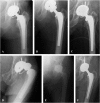Can Dislocation of a Constrained Liner Be Salvaged With Dual-mobility Constructs in Revision THA?
- PMID: 29529660
- PMCID: PMC6259719
- DOI: 10.1007/s11999.0000000000000026
Can Dislocation of a Constrained Liner Be Salvaged With Dual-mobility Constructs in Revision THA?
Abstract
Background: Revision THA to treat recurrent instability can itself be complicated by recurrent instability, and when this occurs, this problem is difficult to treat. Some patients' THAs will continue to dislocate despite use of a constrained liner. One option in this difficult-to-treat group is conversion to a dual-mobility (DM) construct, but there are few data on this approach.
Questions/purposes: (1) What were the Harris hip scores in a small group of patients whose constrained liners were converted to DM constructs to treat recurrent dislocation? (2) What were the redislocation, rerevision, and DM construct retention rates in these patients?
Methods: We conducted a retrospective analysis of a longitudinally maintained institutional database maintained by individuals other than the treating surgeons to identify patients undergoing conversion of constrained liners to DM constructs in revision THA from 2011 to 2014. We identified 16 patients who underwent revision of dislocated constrained liners to DM constructs. Two patients died before 2-year followup, leaving 14 patients available for followup at a minimum of 24 months and a median of 37 months (range, 24-71 months). Indications for conversion to DM constructs included patients with dislocation of multiple prior constrained liners, patients with at least partial abductor functioning and soft tissue tensioning, and patients at very high risk for recurrent instability as an alternative to resection arthroplasty. Ten patients (10 of 14) underwent DM conversion at the time of cup revision, whereas four patients (four of 14) had a DM construct cemented into a preexisting cup. Median age was 65 years (range, 53-93 years). Median number of prior hip surgeries was five (range, three to 10) and seven patients (seven of 14) had dislocated more than one constrained liner.
Results: Harris hip score improved from a median of 57 (range, 55-67) to 84 (range, 68-96) postoperatively (p < 0.001). Three patients (three of 14) experienced a redislocation. Two (two of 14) of these patients were closed reduced and treated successfully nonoperatively; one (one of 14) patient experienced an intraprosthetic dislocation and underwent modular exchange. One patient (one of 14) underwent early resection arthroplasty for acetabular loosening after complex acetabular reconstruction. Overall, all other patients (13 of 14) retained a DM construct at final followup.
Conclusions: Conversion to a DM construct shows promise as a salvage option in high-risk, multiply operated on patients with dislocated constrained liners undergoing revision THA for recurrent instability. The ability to close reduce a dislocated DM construct is a distinct advantage over constrained liners. However, longer followup is required given that three of 14 redislocated, and one of those underwent revision for persistent instability at short-term followup.
Level of evidence: Level IV, therapeutic study.
Conflict of interest statement
All ICMJE Conflict of Interest Forms for authors and
Figures


Comment in
-
CORR Insights®: Can Dislocation of a Constrained Liner Be Salvaged With Dual-mobility Constructs in Revision THA?Clin Orthop Relat Res. 2018 Feb;476(2):313-314. doi: 10.1007/s11999.0000000000000110. Clin Orthop Relat Res. 2018. PMID: 29529661 Free PMC article. No abstract available.
References
-
- Berry DJ, von Knoch M, Schleck CD, Harmsen WS. Effect of femoral head diameter and operative approach on risk of dislocation after primary total hip arthroplasty. J Bone Joint Surg Am. 2005;87:2456–2463. - PubMed
-
- Carter AH, Sheehan EC, Mortazavi SM, Purtill JJ, Sharkey PF, Parvizi J. Revision for recurrent instability: what are the predictors of failure? J Arthroplasty. 2011;26:46–52. - PubMed
-
- Chalmers BP, Arsoy D, Sierra RJ, Lewallen DG, Trousdale RT. High failure rate of modular exchange with a specific design of a constrained liner in high-risk patients undergoing revision total hip arthroplasty. J Arthroplasty. 2015;31:1963–1969. - PubMed
-
- Clavé A, Maurer D, Tristan L, Dubrana F, Lefèvre C, Pandit H. Midterm survivorship of the Lefèvre constrained liner: a consecutive multisurgeon series of 166 cases. J Arthroplasty. 2016;31:1970–1978. - PubMed
MeSH terms
LinkOut - more resources
Full Text Sources
Other Literature Sources
Medical
Research Materials

